|
||||||||
|
Santa
Caterina |
||||||||
|
History A monastery dedicated Santa Caterina just outside the walls of Verona was demolished in 1517. The Republic of Venice had ordered the demolition of all the buildings within a mile of the city walls, resulting in the loss of many religious houses. The nuns moved to houses here and construction of a new church and the rebuilding of structures owned by them began in 1563, with the church consecrated by bishop Girolamo Michele Nichesola of Teano on 23 January 1564. The church had three altars, the greater dedicated to Saint Catherine, the others dedicated to Saints Martin and Ursula. The church and the monastery underwent rebuilding in the 18th century, with a baroque fašade designed by architect Giuseppe Montanari, The altar was also rebuilt at this time, to be more monumental. 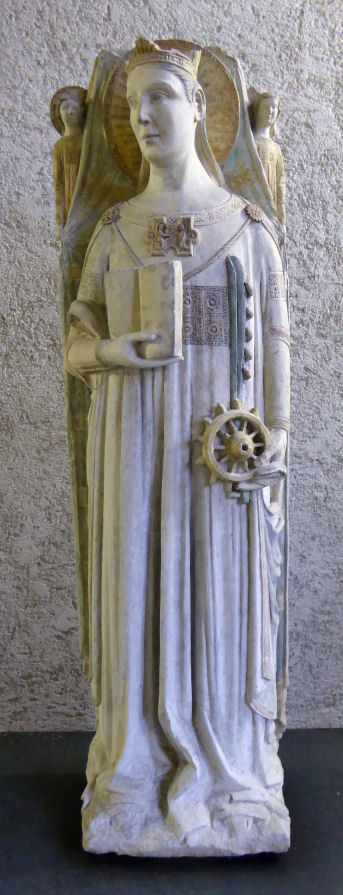 The
monastery was restored by the sculptors Angelo Finali, Ambrogio Pagani,
Pietro Maderna and Giuseppe Rangheri, the painter Michelangelo Prunati,
the stuccoist Giuseppe Antonio Galetti and the masters Giovanni Pozzo and
Pietro Pozzo.
The
monastery was restored by the sculptors Angelo Finali, Ambrogio Pagani,
Pietro Maderna and Giuseppe Rangheri, the painter Michelangelo Prunati,
the stuccoist Giuseppe Antonio Galetti and the masters Giovanni Pozzo and
Pietro Pozzo. Church and monastery were suppressed by Napoleon in 1820, with the church reopening for worship in 1848. Various charities and a hospital have occupied the monastery complex. Fašade The baroque fašade is inhabited by many statues. Above the door is an oval with Saint Catherine holding a palm and the wheel of her martyrdom. In flanking niches are statues of two popes. Along the roofline are two allegorical figures and two saints by Francesco Zoppi. Interior An aisleless nave with a barrel vault and lunettes. Mostly16th-century art - eleven canvases of Stories from the Life of Saint Catherine by Biagio Falcieri, Christ and the Adulteress, attributed to Felice Cappelletti, a Saint Catherine by Sante Creara, and The Saviour with San Mauro and San Benedetto by Domenico Brusasorzi. Lost art The Mystic Marriage of Saint Catherine with Saints Rustico, Martin, Lucy, Zeno and Fermo (The Seven Saints Altar) attributed to the Maestro del Redentore (see below right) and The Thirty Bible Stories panel, are both from the early 14th century and now in the Castelvechio. The Thirty Bible Stories include some unusual scenes, some from the apocryphal gospels, including The Virgin praying at the Temple while her companions spin (see below). A still-polychromed statue of Saint Catherine from the church here by the Master of Sant'Anastasia (see right) is in the Castelvecchio. |
|
|||||||
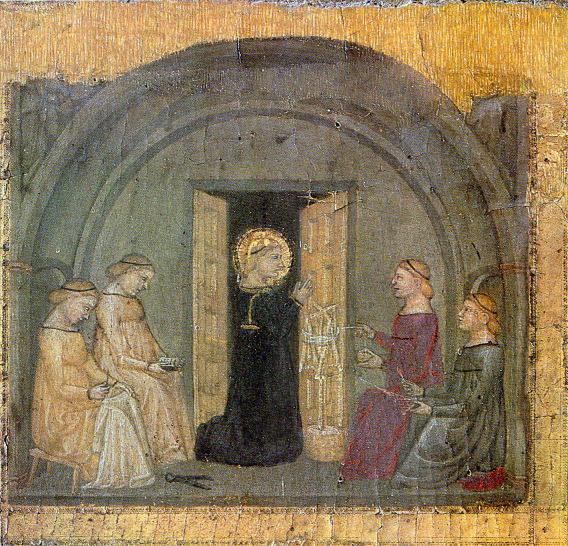 |
||||||||
|
Santa
Caterina da Siena via Venti Settembre |
||||||||
|
The church
|
|
|||||||
|
|
|
|||||||
|
Santa Felicita |
||||||||
|
|
||||||||
|
History The original church here was 7th century, and adjoined a convent. It was rebuilt in Romanesque style after the earthquake of 1117 and consecrated in 1185. The current building became the private chapel of Verona's ruling Scaligeri family. Their rule began after that of the vicious Ezzelino III da Romano in 1259 and lasted until near the end of the 14th century. They became the most powerful signori in north Italy, marrying into the Este, Visconti and Carrara families, their court attracted the likes of Dante, Giotto, Petrarch and Boccaccio. This church became their court chapel and outside the church is their famous family cemetery - the 14th century Scaligeri Tombs somewhat overpower the small church. It is enclosed by a wrought-iron fence featuring ladders, their family symbol, the name originally having been della Scala (of the steps). A design repeated in the iron work of the sanctuary gate inside. Exterior The exterior has bands of brick and stone with small windows, rediscovered during the 19th-century restoration. The side-door is dominated by the monument to Cangrande I della Scala, a larger-than-life figure who died in 1329. He was a friend of Dante, who called him his 'beloved greyhound' and patron to Giotto, who is said to have painted his, now lost, portrait. The equestrian statue of Cangrande is at the very top - it's actually a copy, since the original was moved to the Castelvecchio in 1910. It's by an anonymous Veronese master known as the Maestro delle Arche Scaligere. Below, just over the door, is the prince's sarcophagus, with his reclining figure, attended by his dogs. It's the first of the family's elaborate gothic monuments, the rest having been built in the adjoining family cemetery.  Interior InteriorA nave with two aisles, around 1630 the interior was rebuilt in Baroque style, but late-19th-century work resulted in the restoration of the original Romanesque interior. The interior is impressive - bare-stone, plain columns with square capitals - buff and very antico with brick-stripe walls (with pebbles) and a small nave and apse. The only survival of the original building is a fragment of black and white mosaic floor, to be found next to the altar under a small trap door. There is one small side chapel with a carved panel depicting the Virgin and Child and a decorated ceiling with a painted dove. There's a copy of Mantegna's Dead Christ and a fragment of early-14th-century fresco in a niche behind the altar (see right). The chapel at the end of the left aisle is dedicated to Santa Rita, with a statue and votive offerings. Her cult is currently very strong in the church. Campanile |
|
|||||||
|
|
||||||||
|
Lost art
|
||||||||
|
History The Servi di Maria's previous small church of Sant'Apollinare della Peccana outside the city walls, where they'd been since 1480, was suppressed and demolished by the Venetians in 1517 for defensive purposes. A new church was built for them here and consecrated on the 22nd of April 1519 by Cardinal Marco Corner. The church looked rough, externally, and remained so even after the first interior work of 1600 and post-plague work in 1630. Between 1750 and 1754 five side chapels, the triumphal arch and the main altar were built. The Servi di Maria left in the late 18th century, when the Venetians abolished orders with less then 12 members. In 1782 the church passed to the
Gerosolimitani (Knights of Malta) from the church of San Vitale, which was
prone to flooding. In 1807 the order was abolished by Napoleonic decree
and the church downgraded to an oratory. During this time five statues
were brought here from the church of San Francesco di Paola.
Interior
Campanile
Bibliography |
|
|||||||
|
History Built in 1325 by the Servite order (who had a few years previously built Santa Maria dei Servi in Venice) on land given to them by Cangrande I della Scala. The church was consecrated on December 6th 1329 with building continuing throughout the 14th and 15th centuries. From 1352 a second convent was built across the via Stella linked by a wooden-roofed passage which was destroyed by bombing in 1945, and by an underground passage. During the bombing, in January 1945, the bombs struck the roof, leaving intact the three apse-end chapels, the altar of the Madonna delle Grazie and the altar immediately opposite. The church was rebuilt, during which frescoes were discovered in the apse, and reopened in 1948. Interior The only original parts are the outer walls as the interior was almost totally remodelled after WWII, with stout square pink columns set out from wall. Three chapels of varying sizes down each side. A deep apse and flanking chapels. The second chapel on right has a 14th century fresco of Virgin and Child with Saints John the Baptist and Zeno with presumed portraits of Mastino II (son of Cangrande I) and his wife Taddea da Carrara. The third chapel on the right has a Niccol˛ Giolfino Pentacost. The Guantieri Chapel (to the right of the apse)  Traditionally said to house the Confalonieri family tomb, it was only in 1907 that this was discovered to be the Guantieri family chapel, particularly notably that of Paolo Filippo Guantieri di Nicol˛, a mayor of Florence who belonged to a family of bankers residing in San Marco. His will stipulated burial here pending construction of the tomb, for which he left 700 ducats. He left to his executors the choice of iconography. The execution of the will was opposed by his wife Antonia because of its legacy of 100 ducats a year for 12 years. In 1343 Giovanni Badile was hired to decorate the chapel with over thirty scenes from the life of St. Jerome . The story begins in the upper left and continues on the opposite side. Separating the two bays are the six prophets, while inside the arch is a Crucifixion with St. Mary and St. John, later replaced with a PietÓ . The tomb is pretty spectacular but visibly missing the three figures from the three niches stolen by Napoleon. The apse has a high altarpiece of The Assumption by Felice Brusasorci and a very nice fresco fragment that the church leaflet wants to be by Badile too, or even Altichiero (see right). 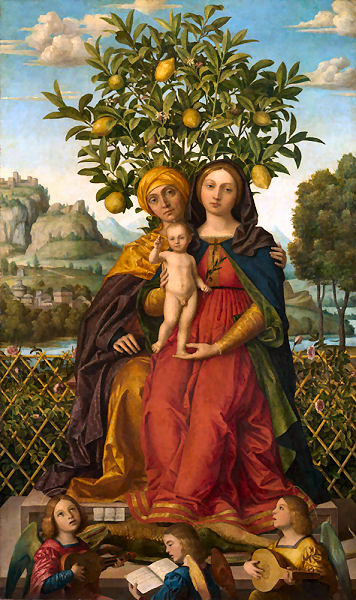 Lost art A panel of around 1520 by Liberale da Verona with the Adoration of the Magi on one side and Saint Peter on the other is now in the Castelvecchio. A Virgin and Child with Saint Anne (sitting under a lemon tree with a dead dragon and three angel musicians) (see right) by Girolamo del Libri of 1510/18 is in the National Gallery in London. It was the central panel of a triptych. The left wing by Paolo Morando, also in the National Gallery depicts Saint Roch, the other was painted by Torbido and showed Saint Sebastian but is now missing. This altarpiece was commissioned for a chapel here dedicated to the Immaculate Conception, and the lemon tree, rose hedge and dead dragon are consistent with this painting being of that subject, as are the flanking panels of the plague saints Rocco and Sebastian. An inscription on the painting which may have settled the issue is too damaged to read. 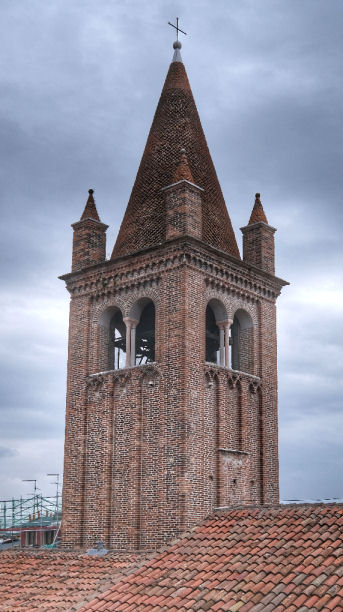 Campanile Built between 1343 and 1345 the bell was bought in 1348 in Venice. Opening times Update April 2023 I never found it open. |
|
|||||||
|
History There is said to have been an oratory on this site, founded in 813 by the Archdeacon Pacifico; but the earliest documented mention is to the 12th-century. Rebuilding work in the 15th century, by the 16th century it was affiliated with the nearby church of Sant'Anastasia. In 1807, following Napoleonic suppression, much of the art was moved there, and the church was returned to worship in 1832, as a subsidiary of Sant'Anastasia, until 1974 when it was used as a carpentry workshop. There has been restoration work more recently. It is now deconsecrated and used for art exhibitions, theatre and events. Art The frescoes are by Girolamo Costantini. Remaining or lost are a Birth of the Virgin and a Nativity by Giovanni Battista Lanceni. In the second chapel is/was a Saint Francis of Sales and Saint John Nepomunk by Michelangiola Lanzeni. Also altarpieces by Eduardo Perini, Paolo Farinati, Pasquale Ottino, Giovanni Francesco Caroto, Michelangelo Aliprandi, and Francesco Turchi. Lost art A Virgin and Child with Saints Lawrence and Jerome panel by Giovanni Francesco Caroto, formerly in the Chapel of Saint Lawrence here, is now in the Castelevecchio. |
|
|||||||
|
this church has its own page |
||||||||
|
Santa Teresa degli Scalzi Largo Don Giuseppe Chiot |
||||||||
|
History Known as the Church of the Scalzi after the Discalced (barefoot) Carmelite nuns who built it. The order came to Verona in 1663 and was initially housed in a Dominican monastery. They then bought some buildings and the city gave them some land, and in 1666 they began building a church and convnet, to designs by Fra Giuseppi Pozzi. Construction wasn't completed until 1750, with the facade finished even later. Initially dedicated to the Virgin of the Annunciation and the Archangel Gabriel, the order rededicated the church to their patron Saint Teresa of Avila. 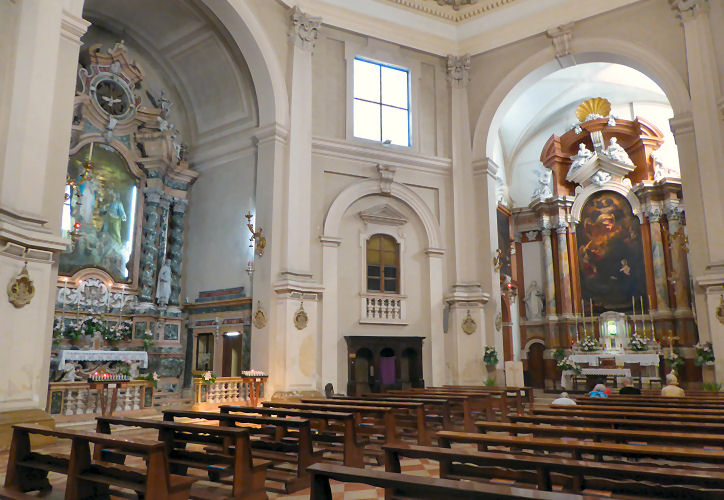 Interior InteriorOctagonal with three polychrome marble baroque altars: the two side ones have twisted columns, grey in the left one, red on the right. The organ is over the door and the other four walls each have a confessional. The high altarpiece is an Annunciation, with God and putti observing from the clouds, an early and still quite baroque work (1697) by Antonio Balestra. The left-hand altar has a painted sculptural group, the right-hand a modern painting, featuring Saint Theresa I imagine, who was celebrating her 500th anniversary when I was here in 2015. The convent and prison The convent was suppressed on 8 July 1806 by Napoleon and was used as a prison from 1883 to 1945. Known as the Carcere degli Scalzi, the prison buildings were destroyed during WWII, on the 11th October 1944, during an allied air raid on a nearby barracks. The remains of the prison, mostly just the fašade, were finally demolished in the 1970s. The photo (see right) was taken just before this demolition, the church is in the background. The street where
the church stands has been named for Don Giuseppe Chiot who was parish
priest at San Luca
and the prison chaplain here, remembered for his impartial humanity
regardless of the prisoner's political affiliations. One of those he
famously comforted was Galeazzo Ciano, Mussolini's son-in law and
one of a group of six members of the Grand Council of Fascism who
went on trial on the 8th of January 1944 as traitors to fascism at
Castelvecchio, were found guilty, and were executed by firing squad on
January 11th 1944. Several films have been made about this episode. A
monument to Giuseppe Chiot stands outside the former prison site, the work
of sculptor Vittore Bocchetta who got to know Chiot during his two
detentions in the prison in 1943 and 1944. |
|
|||||||
|
|
||||||||
|
History The original church on this site was built in the 5th century which makes it, along with the adjacent Chapel of Saints Theuteria and Tosca, part of the oldest Christian complex in the Veneto. The surviving Romanesque elements date from a 12th century rebuilding, consecrated on 12th March 1194, after the earlier church was destroyed by the 1117 earthquake. Work in the 16th century made the church taller 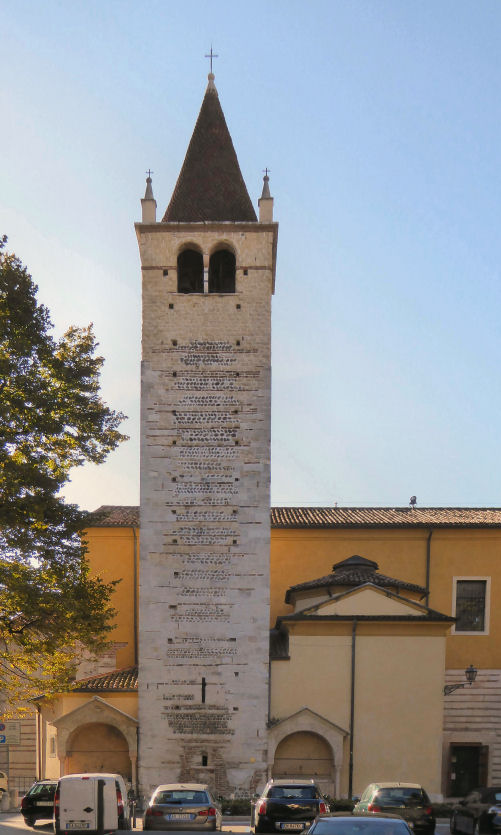 , as is shown on the exterior by the
yellow plaster on the top half of the church, above the stone and brick
layers of the original church, This work also reduced the interior to a
single nave and removed the balconies for the female members of the
congregation. The church was very damaged during a bombing raid on 14th
January 1945. , as is shown on the exterior by the
yellow plaster on the top half of the church, above the stone and brick
layers of the original church, This work also reduced the interior to a
single nave and removed the balconies for the female members of the
congregation. The church was very damaged during a bombing raid on 14th
January 1945.Interior After the attractive exterior and campanile the interior is somewhat dull - aisleless with what might be called a depressed barrel-vault ceiling, and four largish side chapels, the frontmost pair domed and more ornate. A Giotto-ish processional Crucifix of the 14th century in the first chapel on the right. Works by Felice Brusasorci (an Adoration of the Magi), Turchi, Cignani, Ligozzi and some remains of 12th /13th century frescoes. Campanile Finished in 1110 and made of brick, tufa, and cobbles taken from the bed of the Adige. Opening times Monday-Friday 8.00 to 12.00, 15.30 to 19.30 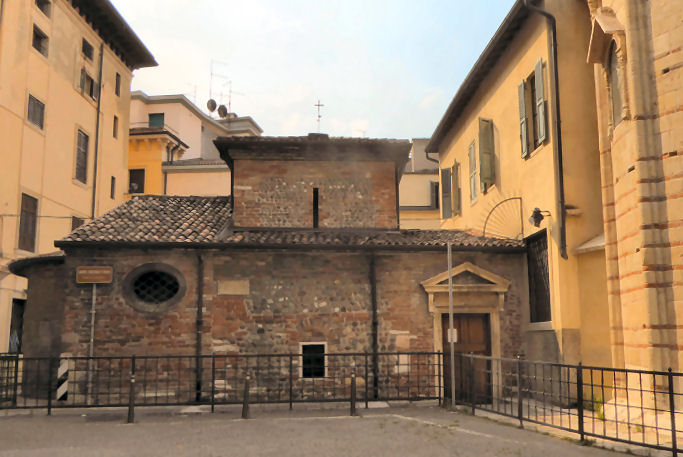 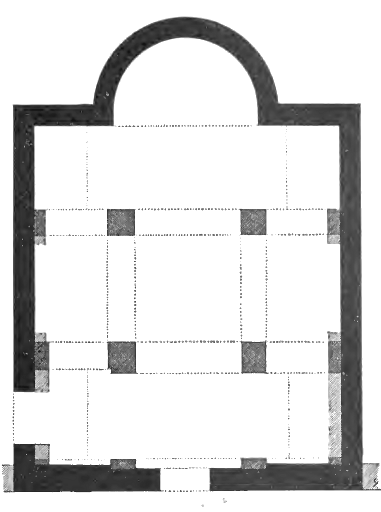 The attached chapel of Sante Teuteria and Tosca (see photo above) was here in the 5th century and consecrated in 751 making it one of the oldest church in the Veneto region. Originally Greek-cross shaped, as it was a funerary chapel, it attained its current form when it became the Bevilacqua family chapel in the 14th century. It is below ground level, with its floor two meters lower than that of the church of Santi Apostoli because that was the the street level in Roman times. In 1160 during reconsecration the bodies of the two saints were found, it is said, and placed in a red marble tomb. To the right of the altar is the tomb of Francesco Bevilacqua, consigliere to Cangrande II. Lost manuscript Presented for exhibition and sale in late 2018, The Book of Saints Theuteria and Tosca is also lusciously illustrated in a book/catalogue called Four Remarkable Manuscripts from the Middle Ages, with text by Christopher de Hamel. The manuscript was, he says 'surely made' for this chapel and 'most probably' written for Bartolomeo della Scala and his wife Costanza of Antioch. The sale was the first appearance of the manuscript for four hundred years. It had passed to the convent of Santa Maria delle Vergine in Campo Marzio in the late 14th century. Lives of the Saints The above-mentioned manuscript is the longest and most detailed account of the lives of Saints Theuteria and Tosca. Theuteria was an English woman of noble birth who the English King Osgualdus took a fancy too. She, having already dedicated her life to Christ, rejected him, so turning the king against her and her father. After initially hiding in a fortified tower she finally fled to Europe, ending up in Verona, where she met and spoke with Tosca, an anchoress living in in a cell outside the city, who is said to have been the sister of Proculus, the Bishop of Verona. Meanwhile the Devil had made King Osgualdus send agents to find Theuteria. When she heard this she fled back to Tosca, but the hermitage had no door, only a small window. But miraculously Theuteria was born aloft and through the window, so that when the agents arrived they found no trace of her, and the window had been covered in spider webs - the scenes illustrated in a spread from the above manuscript see right. The two women became famous and their hermitage much visited, with their relics responsible for many miracles after their death. Opening times A group called Verona Minor Hierusalem staffs touristic visit times for this church, amongst others. The times they publicise for this church are Saturday 10.00 - 5.30 The church may be open at other times too. |
|
|||||||
|
History An earlier church on this site existed by the 9th century, but being outside the city walls it was burned down during the Magyar invasion of 951. The building of this church and its Cassinese Benedictine monastery began on the 13th of October 1464. Building was completed on 6th April 1466 and an inscription inside records the date of consecration as February 14th 1483. 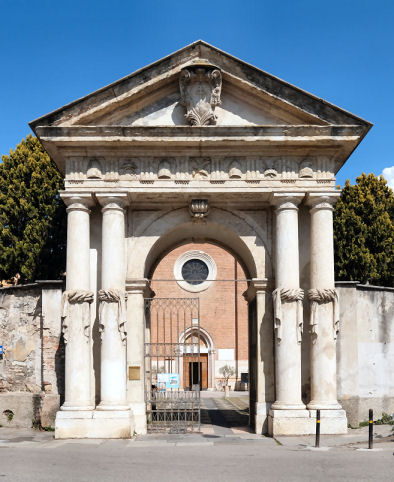 More work in the 16th century - the interior was
restored in 1510 and in 1575 the chancel was extended and
barrel-vaulted and frescoed by Paolo Farinati. In 1688 the enclosed
baroque courtyard was built, along with its monumental entrance archway. More work in the 16th century - the interior was
restored in 1510 and in 1575 the chancel was extended and
barrel-vaulted and frescoed by Paolo Farinati. In 1688 the enclosed
baroque courtyard was built, along with its monumental entrance archway. In 1770 the monastery was abolished by decree of the Venetian Senate, but the church and monastery were immediately purchased by Benedictine nuns from San Daniele, who settled here, carrying out renovation work on the monastery and remaining until the Napoleonic suppression of religious orders in 1806-10. Over the door in the lunette is a fresco of The Virgin with Saints Nazario and Celso by Paul Ligozzi from 1601. The gateway The gateway to the area in front of the church, made in 1688 by stonemason Antonio Saletti, (see right) is known as 'the portal of the sheets' because of the perfectly positioned carved representation of cloths tied around the two pairs of Doric columns. Interior A nave with aisles five bays long with large square pillars. In the left aisle the second chapel has a Virgin in Glory with Saints John the Baptist, Anthony Abbot, Benedict and Blaise, signed and dated of 1543, by Antonio Badile. The page bottom right is said to be the young Paolo Veronese, Badile having been Veronese's teacher (and later father-in-law) and the painting having been made during Paolo's apprenticeship. The fifth chapel has a Virgin and Child with Saints Peter, Paul and Margaret by Domenico Brusasorci, with a lunette (Christ Entrusts the Keys to Saint Peter) by him too. The left arm of the transept is the spectacular chapel of San Biagio (Saint Blaise) (see below right) built to house the saint's relics, which were given to the monastery in 1174 by a German crusader along with those of Saint Juliana. He had, it is said in the leaflet provided by the church, 'found them in the orient'. The chapel's decorative conception and most of its frescos, are the work of Giovanni Maria Falconetto, begun March 7th 1488, completed 1528. His work was completed by Domenico and Francesco Morone between 1497 and 1499, with contributions by Cavazzola and Bartolomeo Montagna. This chapel saw conservation work in 1996. Also here is the 1519 altarpiece by Francesco Bonsignori of The Virgin and Child in Glory with Saints Blaise, Sebastian (stripped and bound and awaiting punishment) and Juliana, who is chaining the devil, with a slightly later predella by Girolamo dai Libri (The Miracle of Saint Blaise (where he saves a boy choking on a fish bone whilst being taken to jail), The Martyrdom of Saint Sebastian and The Martyrdom of Saint Juliana) of 1526. Too far away to appreciate. Inside the arch above is an Annunciation by Cavazzola. Marble altar tombs of Saints Biagio and Juliana by Bernardino Panteo. Martyrdom of two saints. The apse is frescoed by Paolo Farinati (and signed and dated 1575) also four paintings by him of Stories of Saint Celso. In the right transept is the door to the Sacristy, which has 15th century inlaid walnut cabinets and a triptych by Felice Brusasorci (Virgin with Saints Peter, Paul, Augustine and Benedict). The right aisle second altar has an Annunciation and lunette of Adam and Eve by Paolo Farinati. The fourth an Ecce Homo by Flacco, a pupil of Badile 1529-75. The first aisle has a movement-filled Conversion of St Paul by Bernardino India. The paintings on the organ shutters, above the door, are by Giovanni Battista Brusasorci, Domenico's son, and depict Musical Angels. Campanile Venetian style and built by Francesco da Castello in 1550/51. Cave art? Old guide books speak of Ancient Christian wall paintings in chapel/caves carved into cliffs behind the church - The most ancient pictorial remains in the Venetian territory - and a tomb which has never been opened. 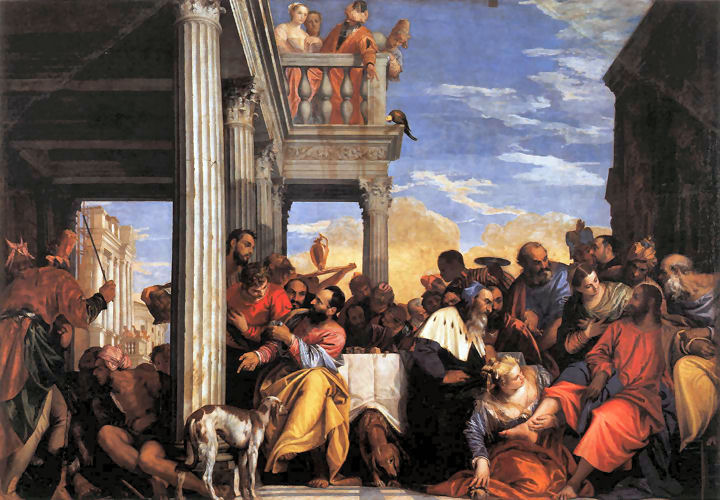 Lost art A pair of painted limestone figures of Saints Gregory and Ambrose from c.1320/50 which were seen in the chapter house here in 1800, but which may have originally been displayed elsewhere. The fašade is the most likely place, but their unweathered condition suggests that they have always lived indoors. They are now in the V&A in London. A panel fragment, from a polyptych painted for the high altar here in 1500/02, depicting the top halves of Saint Blaise and a Bishop Saint (San Mauro?) by Bartolomeo Montagna (who also contributed to the frescoes in the chapel of San Biagio here) is in the Castelvecchio. Four more fragments, showing a Dead Christ Supported by Angels and three pairs of saints (two pairs full length) are still here (in the right transept?) There were originally seven panels, the central one being a Virgin and Child, now lost. Large fresco panels of The Baptism of Christ with four roundels of the Evangelists, by Franceso Morone, are in the Castelvecchio. The Feast in the House of Simon of 1556 by Paolo Veronese (see above) was painted for the refectory here. It is the earliest surviving of his big feast scenes and is now in the Galleria Sabauda in Turin. A copy by Sebastiano Ricci, made in 1716-18, is in the British Royal Collection. A Mystic Marriage of Saint Catherine by Pasquale Ottino is now in the Castelvecchio. An antiphonal from this church illuminated by Girolamo dai Libri and his father's workshop is now in the V&A's National Art Library (MSL/1866/4929) in London. A date of inventory of 1492 is noted on the first leaf. Opening times A group called Verona Minor Hierusalem staffs touristic visit times for this church, amongst others. The times they publicise for this church are Saturday 10.00 - 5.30 I assume that the church will be open at other times too.
|
|
|||||||
|
History Legend has it that Christianity was introduced to Verona when Saint Syrus celebrated the first mass here after performing a miracle, having stopped off on the way to becoming the first bishop of Pavia. Tradition has it that this mass was celebrated in a grotto once accessible through a passage behind a panel in the apse here. Legend also states that he was the small boy who gave the five loaves to Jesus during the miracle of the multiplication of the loaves and fishes. The dedication to Saint Liberata was added in the 14th century. Now part of the Roman Theatre complex, the church was founded in the 10th century, built above a section of the arcading of the theatre. It then passed to the Confraternity of the Blessed Body of Christ in 1518. The original church is now the trapezoid-shaped nave. The church was enlarged in the 17th, which work involved the demolition of the adjacent 14th-century church of Santa Maria della Cava. The fašade has a baroque staircase but the original 14th century doorway and porch. Following Napoleonic suppression in 1806 the church and it fittings were put up for auction, but were reacquired by the confraternity and the church reopened in1814. The church was spared demolition in the 19th century as part of the project to redevelop the theatre complex, but in becoming part of the archaeological complex it fell out of use. It was 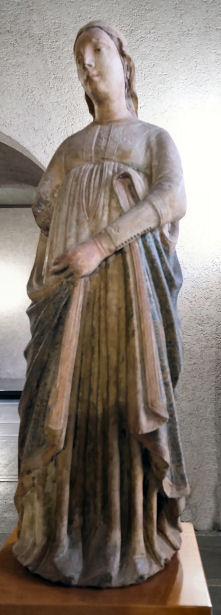 abandoned just before WWII and the confraternity disbanded.
abandoned just before WWII and the confraternity disbanded.Interior Centrally planned and baroque, there are four nave altars and two side chapels. In the nave to the right of the apse entrance is an Assumption by Francesco Morone from 1524. The first chapel on the left has a Virgin and St Gaetano , showing the saint's vision of the Virgin, of 1751 by Giambettino Cignaroli, who is buried in the nave here, he having been a member of the Confraternity here, along with artists Francesco Morone and Pasquale Ottino. Also from the 18th century are the very decorated high altar and presbytery, the German-made walnut choir stalls behind (1717-1729) begun by Andreas Kraft and completed by Petendorf and Siut, and an Annunciation painted by Ridolfi. Lost art Four damaged fragments in tempera on panel by Francesco Morone, showing the Virgin, Saint Paul, Saint Anthony of Padua and Saint John the Evangelist are in the Castelvecchio. A still partially polychromed 14th-century statue of Saint Liberata by a sculptor from the circle of the Master of Sant'Anastasia (see right) is in the Castelvecchio. Opening times A group called Verona Minor Hierusalem staffs touristic visit times for this church, and four more nearby. The times they publicise are Thursday, Friday, Saturday, Sunday 10.00 - 5.30. I'm not sure how this will work, with the church being in the Roman Theatre complex. Update April 2023 The website mentioned above says that this church has been closed for restoration work (since November 2019) and there still does seem to be considerable work going on in the theatre complex.
|
|
|||||||
|
History 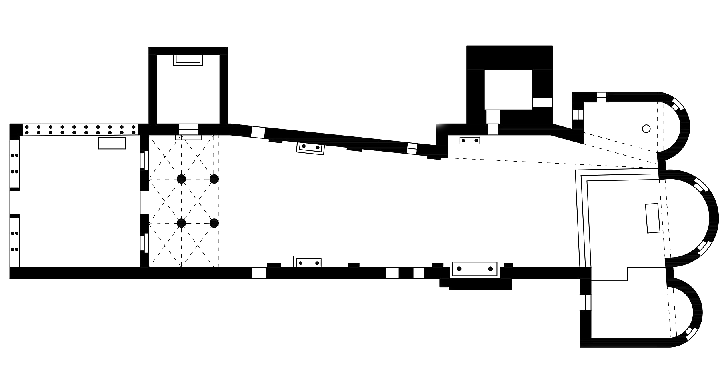 A church and monastery has been here since the late 11th century, built by Vallombrosian friars, a stricter order on Benedictines, from around 1073. The church was consecrated on 12th January 1117. The chapel north of the chancel remains from this first Romanesque church, as does the campanile. Parts of the portico date from the 12th to the 16th centuries, a period during which the church underwent various building works. In the 14th century Abbot Bartolomeo lengthened the building and commissioned the Trinity Supported by Angels in the new apse, as well as the Coronation of the Virgin with Saints by Turone di Maxio now in the Castelvecchio museum. The fašade under the portico dates from enlargement in the 16th century. The Vallambrosians left in 1441 and from 1536 the complex was used as a refuge for women. A loggia with a grating was built for them in the church. The church had fallen into ruinous disuse by the 19th century. Both cloisters and one of the east-end chapels was destroyed during bombing on 6th April 1945. The late 20th century removal of whitewash led to the subsequent restoration of discovered frescoes. 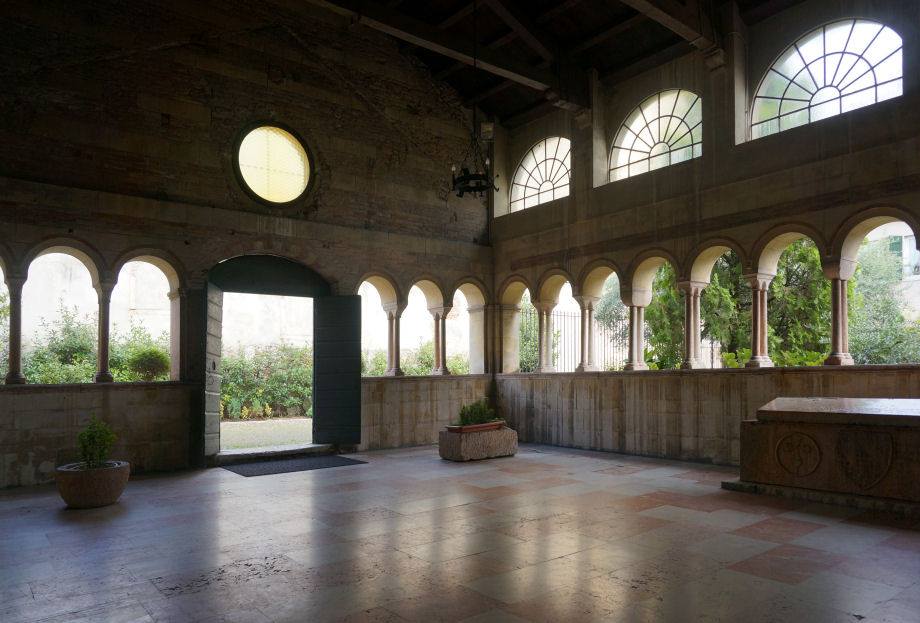 Interior Entry is through an odd large porch (see above) suggestive of a small cloister. The interior is long and narrow with a deep organ gallery over the door and much old fresco work. There are a pair of flanking altars with frescoes as you emerge from under the organ gallery. On the left is a very damaged Mystic marriage of Saint Catherine. On the right, one under the gallery, are works by Domenico Brusasorci and Felice, his father. Panels of 14th century frescoes on the left hand wall as you approach the east end, dated 1359, and over and in the chancel. The top row on the left wall depicts Stories from the Life of Christ, the lower Stories from the Life of Saint Martin. The Annunciation on the arch over the apse is said to be by Martino da Verona, the courtly Apostles in the vaults the work of Jacopo da Verona. Abbot Bartolomeo is depicted beneath Gabriel in The Annunciation, the whole wall seemingly built asymmetrically to fit him in (see below right). A pair of sweet little transepts flank the apse. The irregular shape of the right-hand one is said to represent the extra pressure imparted on the right-hand side of the cross by Jesus' shoulder. On right hand-wall opposite the wall of frescoes are three unframed canvases, two by Brusasorci and one by Jacopo Ligozzi. Lost art The Trinity Polyptych by Turone di Maxio (see below) signed and dated 1360, depicting the Trinity flanked by Saints Zeno, John the Baptist, Peter and Paul, from the refectory of the convent here, but probably originally on an altar in the church, went to the Castelvecchio in 1812. It had two more panels depicting The Annunciation, which are now in a private collection. A Crucifixion fresco panel (now in three parts) by the Circle of Altichiero, from the cloister here, has been in the Castelvecchio since 1879. Augustus and the Sybil, a rare work on panel by Gianmaria Falconetto, which looks very like a stage set, now in the Castelvecchio, came from the refectory of the convent here. 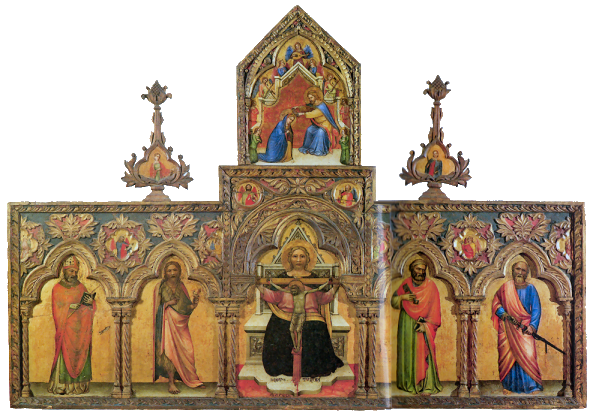 Campanile Part of the original building, the tower rests on a foundation of stones from Roman ruins. Opening times None posted, but I've usually found it open when you'd expect it to be, if that's any help. |
|
|||||||
|
History Tradition has it that the original church here was built in the 5th century, and was the cathedral of Verona from 412 to 750, erected on the burial site where 40 Veronese martyrs were interred, and that it was destroyed by Theodoric. But the original church here was likely a cemetery chapel housing the relics of St Stephen. Following this rebuilding in the 8th century it would have been rebuilt again in the 10th century as, being outside the city walls, it was burned down during the Magyar invasion of 951. Following the earthquake of 1117 it was rebuilt yet again. The 12th-century fašade was used to record local events, with inscriptions, such as floods and the collapse of bridges. The visit of the German Emperor Frederick II in 1245, when he spent a month in Verona, is commemorated. His entourage included 24 camels, 5 lions and an elephant. The apse was remodelled in the 14th century.
Interior
In the right transept is a panel depicting the Virgin and Child with Saints Peter and Andrew by Giovan Francesco Caroto (1543). In the left is Christ Carrying the Cross, with Saints by Domenico Brusasorci (1547).
The crypt
Lost art |
|
|||||||
|
The procession of the
Duca de la Pignata
Lost |
||||||||
|
San Bartolomeo della Levata
San Clemente
San Giacomo alla
Pigna
San Sebastiano
|
Sant'Andrea
Santa Croce Santa Felicita Santa Maria
degli Angeli
Santa Maria della
Fratta
|
|||||||
|
Rumours to be followed up |
||||||||
|
|
Santi Cosma e Damiano
Santo Spirito |
|||||||
|
|